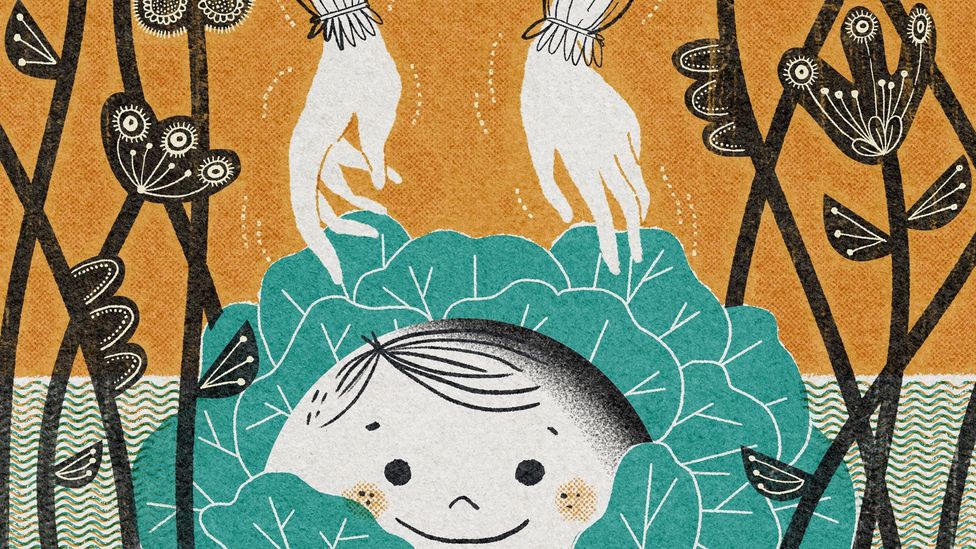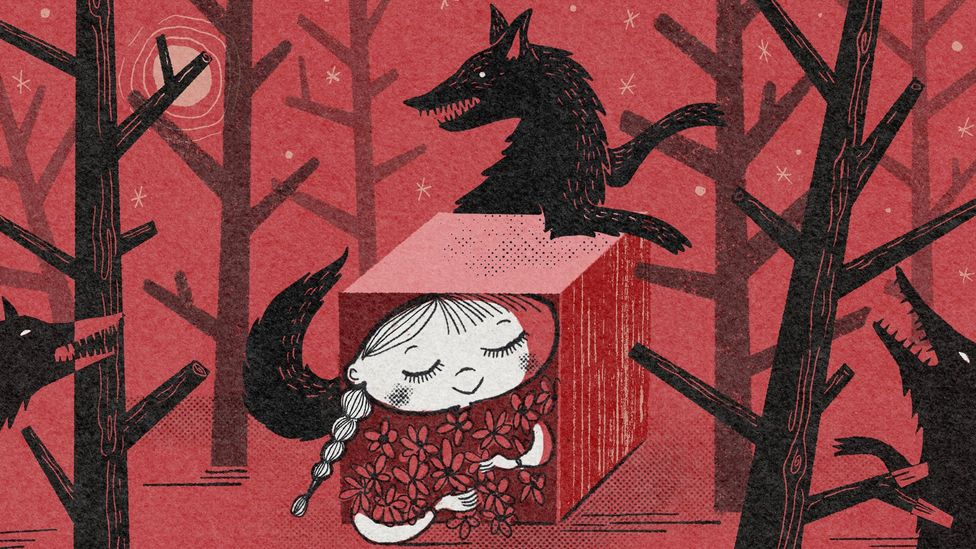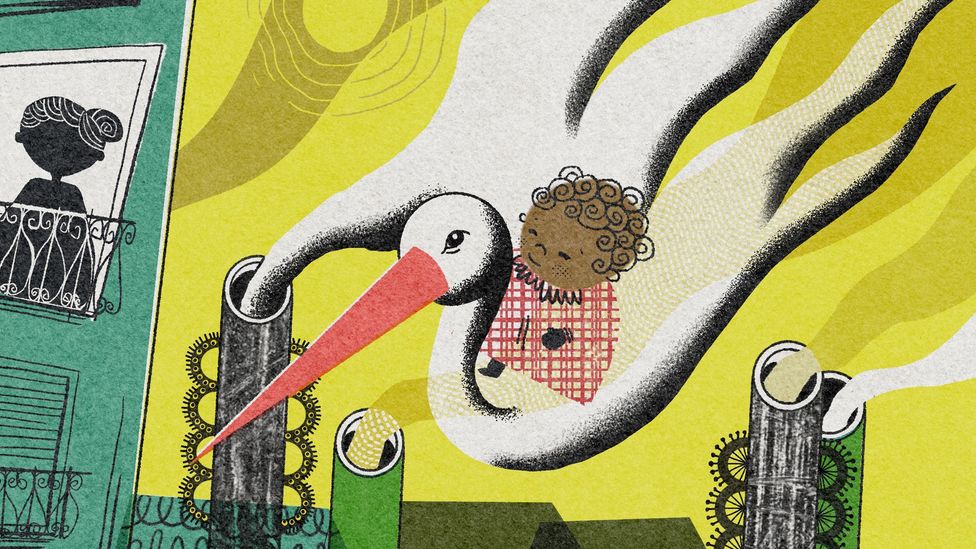When I was five years old, my grandmother gave my younger sister and me a picture book which outlined in detail how a man and a woman have sex to create a baby.
We were enthralled. Until this point, our only reference point for where babies came from was Disney's Dumbo being delivered to his mother by a stork.
My embarrassed mum placed the book on a high shelf, hoping that would be the end of it. My sister and I, of course, climbed on a chair to get it and continued perusing the pictures, giggling and pointing incredulously at the naked bodies, as my parents awkwardly tried to dodge our barrage of questions.
My parents had "the talk" with me a few years later, when they thought I was the right age to learn the truth about sex, childbirth and puberty. Sex education was also part of the curriculum at both the Dutch and English primary schools I attended. But many children across the world aren't properly taught about sex until they get to secondary school, if at all.
"There are definitely still plenty of children who are getting folk stories or mythical answers about where babies come from," says Lucy Emmerson, chief executive of the Sex Education Forum in the UK.
Could such myths and euphemisms – whether they are classic tales of babies delivered by storks or found in cabbage fields, or more modern, spontaneous inventions – actually affect our attitudes to sex in the long run? And how did they come to be in the first place? A closer look at some of the oldest folk stories about sex and babies reveals fascinating insights into why people tell them – and how we might do better.

In Scotland, children placed cabbage leaves outside their homes to ask fairies to bring them a new sibling (Credit: Emmanuel Lafont)
The baby-stealing crane
Growing up, I was frequently confronted with the stork tale. Disney films, cartoons and picture books all told me that newborn babies were found and delivered to their parents by these elegant, long-legged birds. The original myth, however, has a darker twist, with the bird stealing – or rescuing, depending on your perspective – the baby.
The myth can be traced back to ancient Greece, where cranes, which share many similarities with storks, were associated with stealing babies. In Greek mythology, Hera, the goddess of childbirth, turned her rival Gerana into a crane with an elongated neck because she was having an affair with her husband Zeus. Unwilling to part with her newborn child, Gerana picked up the baby, wrapped it in a blanket, and flew off with the infant in her beak.
Over time, the crane was conflated with the stork, says Paul Quinn, senior lecturer in English literature at the University of Chichester in the UK. "There's a link with domesticity because storks nest on people's roofs." Another mythological layer was added by the pelican, which in European medieval literature was a symbol for the Virgin Mary and the nurturing mother, says Quinn. The pelican was also associated with breastfeeding, he says, as the bird is described as picking at its chest to feed its chicks in literature.
By the early 19th Century, the stork started appearing in fairytales. Again, it tended to appear as a symbol of domestic life and the family. "Storks have always been associated with family life because they were visibly seen nursing their young," says Marina Warner, professor of English and creative writing at Birkbeck College, University of London. In fairytales, they often come to the rescue of human babies. "The stork finds babies in wells, ponds or marshes and with her beak she pulls the babies out and bundles them in a sling," says Warner.
This version was popularised by Hans Christian Andersen's story The Storks, which was published in the early 19th Century. In Andersen's tale, the white birds seek out "the pond in which all the little children lie, waiting till the storks come to take them to their parents".
"The prettiest little babies lie there dreaming more sweetly than they will ever dream in the time to come," Andersen writes. "All parents are glad to have a little child, and children are so pleased with a little brother or sister."
But there is a cruel twist to Andersen's story: badly behaved children are given a dead baby sibling by the stork as punishment, to make them cry over their "little dead brother".
Despite this horrific ending, Andersen's tale quickly swept through the English-speaking world. In Victorian Britain, the stork became a useful way for embarrassed parents to explain the facts of life to their children and conceal the realities of sex and childbirth, says Warner.
In its benign form, the stork myth still lingers in popular culture. To this day, a common birthmark on a newborn's skin, caused by blood vessel malformations, is still called a "stork bite", highlighting the tale's influence.
A similar confluence of ancient beliefs and parental squeamishness lies behind another colourful myth about how babies are born: the idea that they are grown in cabbage patches.
Folk tales provide quick answers - and transmit coded messages
The cabbage patch myth possibly originates in various beliefs and practices around plants and fertility.
In Scotland, it was common for children to place cabbage leaves outside their homes if they were asking fairies to bring them a new sibling, says Quinn. Women also used to eat cabbages to boost their fertility and ensure a successful pregnancy, he says.
Just like the child rescued by the stork, the cabbage patch baby is "found in nature and discovered as part of the natural world", says Warner. In French the term of endearment for a young child is "mon petit chou" ("my little cabbage"), she notes.
The story also lends itself to sweet, child-friendly illustrations. A series of postcards published in 1906 by three sisters in New Zealand show a gardener tending to a field of babies growing in cabbage patches. Well-dressed Edwardian couples are shown wandering among the fields, browsing the babies growing there. The gardener picks the chosen cabbage baby and presents it to the couple. Similar tales of children being grown in gardens and orchards exist around the world, such as a much-loved Japanese folk myth about a boy emerging from a peach.
For Victorian parents, tales featuring the stork and cabbage patch babies offered a "way to explain things to their children that they couldn't explain to them otherwise", says Quinn.
"They didn't know what a female body looked like inside … they just imagined it to be an inverted male body," he says. "So how do you explain that? The natural world is the obvious model to go to."

For Victorians, the story of Little Red Riding Hood contained an important message about the risk of talking to strangers (Credit: Emmanuel Lafont)
Warner agrees: "A lot of parents wouldn't have understood their own anatomy and would have really struggled to explain the facts of life to their children." The tales provided a handy answer. But parents also used them to transmit coded messages about sex and relationships, she says.
Take Little Red Riding Hood, a European fairy tale about a girl who goes to visit her granny, and on the way, stops to talk to a seemingly friendly wolf. During the Victorian Age, parents would tell their daughters this fairytale to warn them not to interact with men they didn't know, says Warner. This was before women had access to any contraception so when it came to romance and pre-marital sex, "the dangers were very great", she says. There was also "real social shame" associated with unmarried pregnancy, she adds.
Harmful myths?
While the baby-delivering stork remains a popular motif on greeting cards and gifts, it may be hard to imagine 21st Century parents seriously trying to persuade their children that this is how babies are born. But other myths and euphemisms are still surprisingly common, says Spring Chenoa Cooper, associate professor of sexual health at the City University of New York School of Public Health. One reason is simply that many parents are still unsure when and how to talk about the facts. "A lot of people don't know the actual scientific things they should be saying and they don't know how to explain sex to their children."
However, euphemisms that feel comforting and safe for parents in the moment can in fact be confusing for children, says Emmerson at the Sex Education Forum in the UK. Parents may find it difficult to correct the story later, and admit that they lied. She recounts how an 18-year-old girl visited a sexual health clinic to ask whether she could be pregnant after semen landed in her belly button.
"She was engaging in a relationship but she didn't understand sexual health or her own anatomy," says Emmerson.
Cooper agrees that "when people make assumptions based on myths and misinformation, it can have harmful results".
In Australia, the HPV vaccine, which is given to young people to prevent cervical cancer, was commonly referred to as the "sex vaccine". This led some girls to wrongly believe that it protected them from sexually transmitted diseases and meant they and their partners did not need to use condoms, says Cooper.
Another danger of using euphemisms is that it can set a pattern of not discussing sex openly, experts say, making it difficult for children and teens to confide in their parents. "They might experience assault, and feel they cannot speak up about it, get pregnant and not tell anybody or get a sexually transmitted disease and not treat it," says Cooper. "The fear of talking about these things can cause ramifications for their whole lives."

The stork story can be traced back to ancient Greek myths about cranes transporting babies (Credit: Emmanuel Lafont)
FAMILY TREE
This article is part of Family Tree, a series that explores the issues and opportunities families around the world face today – and how they'll shape tomorrow. You might also like:
- Autism: Understanding my childhood habits
- When to talk to your kids about sex
- How your family shapes your body image
Climb other branches of the family tree with BBC Culture and Worklife.
From storks to cups of tea
School may not necessarily fix such gaps and misunderstandings. In the US, just 29 of the 50 states mandate sex education. According to the Centers for Disease Control and Prevention, fewer than half of high schools and less than one-fifth of middle schools teach key topics for sex education. In the UK, children are taught about relationships in primary school, but it is not compulsory for primary schools to provide sex education classes, which only become mandatory at secondary school.
But Emmerson says some school resources in the UK are failing to properly teach children about sex.
One example is the video "consent, it's simple as tea" which was created by Thames Valley Police and is widely shown in schools, she says. The video likens initiating sex to offering to make someone a cup of tea and reminds young people that someone wanting a cup of tea (or sex) one day doesn't automatically mean they want it another day.
Emmerson says she has received complaints from young people that the video is "too euphemistic and fails to refer to sex at all".
"So if a parent was thinking 'if I say nothing, they're going to understand that when they arrive at school', that is probably not the case," says Emmerson.
It seems that my grandma was right, then, in giving me that picture book about sex and babies. But for parents who can't quite imagine that level of openness and factual detail, researchers suggest starting small, with short, simple chats rather than a big talk. It is about "anticipating rather than being caught out", says Emmerson. "[It's about] realising that a lot of opportunities will present themselves before reception or nursery to give their children some vocabulary around their bodies and also around their emotions."
For example, if a young child asks how babies are born, "it's enough to say that the baby grows in the mother's tummy and comes out of the vagina," she says. "It's not about explaining sexual intercourse. It's just about providing a factual response that isn't a fabrication."
"Whenever a child asks you a question about sex, answer it very simply and directly," says Cooper. "You don't need to sit them down and lecture them for an hour… that might scare them to ask more about it." Vital concepts like consent and boundaries can be taught from the start. For example, you can tell toddlers to check before hugging others and explain to them why asking for consent is important, she says.
Does that mean there's no place for charming stories about storks and cabbages in modern parenting culture? The answer might be, perhaps, to enjoy these folk tales for what they are – colourful feats of the imagination, handed down by previous generations. In any case, my grandma's book delighted and entertained me as much as any fairy tale – and was certainly more thrilling than the story of the stork.


